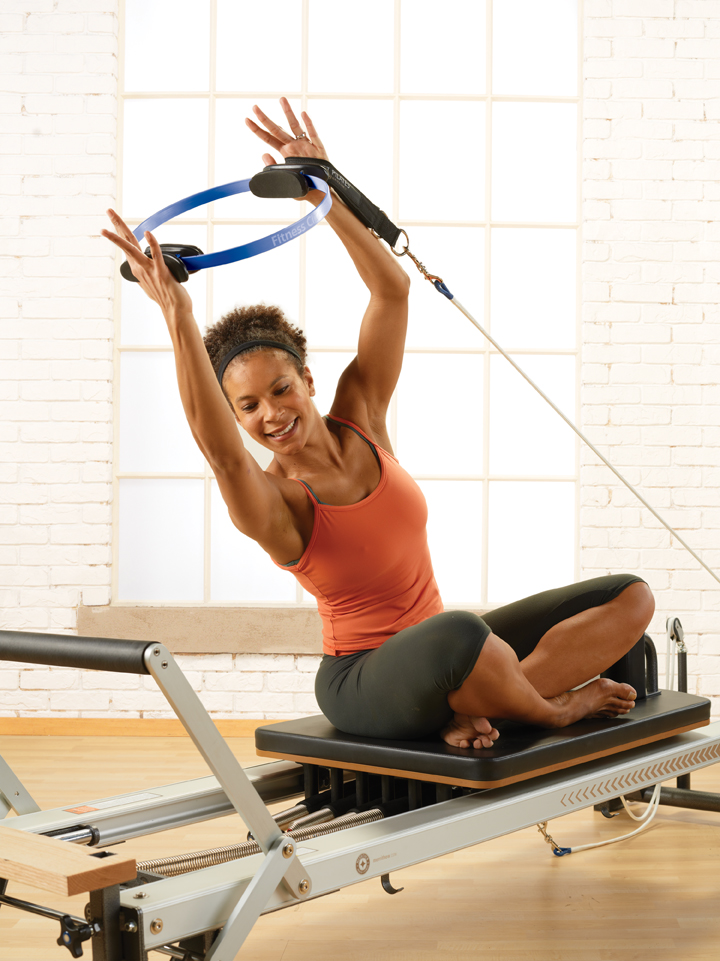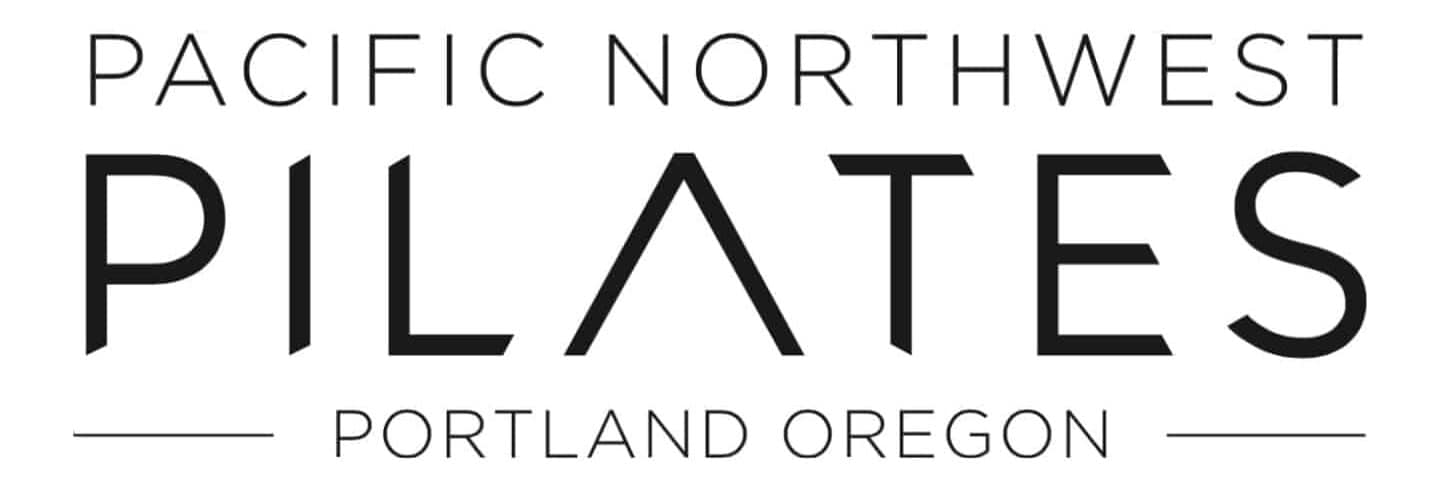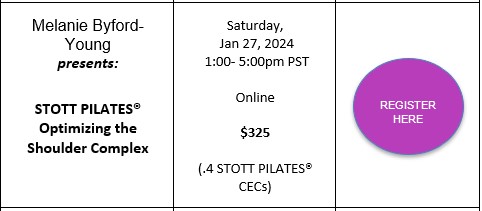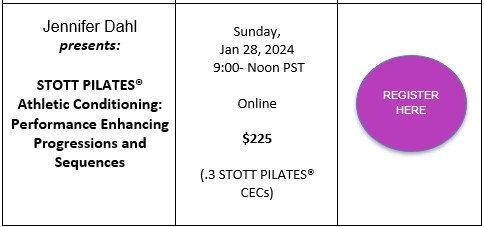In January of 2024, STOTT PILATES® Master Trainers Melanie Byford-Young and Jennifer Dahl will kick-off the first of five events in The Synergy Series—a selection of workshops and lectures specifically designed to bring together expert voices in the fields of therapy, health and fitness. Their collaboration will focus on shoulder impingement, and even more, helping movement professionals understand the path needed to assist injured clients through the phases of rehab and therapeutic exercise back to full recovery.
Recently, I had the pleasure to interview the dynamic duo. —Leslie Braverman, author.

Our conversation begins with a surprising burst of liveliness as Jen Dahl relays the details of her recent teaching trip in London— four days at the Mindful Movement Symposium for Merrithew Health & Wellness. The relentless pace of a compressed schedule mixed with an interminable amount of human interaction has left Jen giddy and eager to have a few quiet days at home. Nevertheless, Melanie and Jen reminisce and laugh as they share experiences and compare their personal teaching trials and triumphs.
Over the last 20 years, Jen and Melanie (though rarely together) have traveled the globe collecting miles—and many stories—from teaching at trade shows, conferences and independent studios. While they are so different in appearance and education, their core outlooks are deeply harmonious. Together, they share a clarity about the powerful benefits of movement, a passion to teach, and curiosity to learn—they are each the perfect complement to one another.

Q: I can tell that you’re excited to work together. What inspires you about this collaboration?
JD: I’m a big fan of Melanie and her teaching. We met in Toronto many years ago and while we come from different backgrounds our skill sets are very compatible. Together, I think we help fill the gap between rehab—the necessary, early stages of post-injury in which Melanie excels—corrective exercise and STOTT PILATES which we have both taught for years, and high-performance training that is needed to return to recreational or professional activities and full recovery.
Once you have an injury you’re never the same, and that means, you have to approach movement differently afterwards.”—Jennifer Dahl
MBY: Jen is an impressive teacher and thinker, and the way she moves is energetic, beautiful, and inspiring. Her movement and educational background enable her to teach with great depth of understanding—so she knows the details, yet she has the experience to recognize the bigger picture. This ability makes her teaching very interesting, relevant, and approachable. I’m excited to work closely with her. I know I’ll learn a lot from her.
Q: You’ve both dedicated a significant amount of your professional careers to teaching, co-creating, and enhancing STOTT PILATES education. Why Pilates and specifically why STOTT PILATES?
MBY: During my physiotherapy training, I learned many exercises for the early stages of healing, but they tended to be isolated, joint specific movements versus whole body, integrated exercise. When I discovered Pilates, I was both fascinated and excited by how the system of exercises incorporated complete ranges of motion, so every joint, nerve, muscle and fascial sling were both challenged and integrated in multiple ways. In STOTT PILATES, the biomechanical principles are combined with a curriculum that balances mobility, stability, strength, and power—it was a practical and powerful way to blend my therapeutic perspective and a holistic approach to movement and healing.
…the misapplication of information and lack of critical reasoning has inspired me to help movement professionals have access to current, well-researched information so they can provide sound care, problem-solve, and work with complex clients more effectively.” —Melanie Byford-Young

JD: I think a lot of people know me as a contemporary dancer, but I also was a runner, long jumper, junior pentathlete and mid-distance runner too! Unfortunately, my knees were injured from all the jumping and high impact, and STOTT PILATES became a huge part of my knee rehabilitation. I remember my physio practically had to kick me out—she knew it was time for me to make the transition from PT back to more integrated movement and STOTT PILATES made that possible. As we all know, STOTT PILATES is a brilliant exercise system and it was just the thing I needed to help me transition from physio to slow, integrated movement, and I loved it. That’s how I started STOTT PILATES and began the path to becoming an instructor.
Q: The focus of your workshop series is on shoulder impingement. Why did you choose to focus on this topic?
JD: The shoulder is a complex joint with a lot of movement potential, and in my experience, it can be challenging to get people with shoulder pain/impingement out of the therapeutic mind-set and back to having confidence so they can get to the next levels of recovery. Many recreational athletes, for example, have a lot of resistance and fear post-injury, so it’s important to get people away from just doing slow, corrective exercise, where they’re thinking about every detail, and back to integrated, varied, high performance activity.
MBY: Shoulder impingement is very common and it’s typically the result of micro-traumas, alignment issues, repetitive stress and/or inappropriately applied cues and beliefs one holds about movement (e.g. “I need to put my shoulders down and back all the time.”) Because the shoulder girdle is so mobile, it compensates for other imbalances throughout the body, which can result in misuse leading to irritation; and because people use their shoulders in wide variety of daily and recreational activities, it’s vulnerable to persistent pain and recurrent injury.
As Jen said, the shoulder is a complex joint, so ‘one size fits all’ approaches often do more harm than good. We’re living in the era of sound bites and social media, so I see a lot of misinformation and over-simplistic language being shared about shoulder mechanics. Though there is some good advice out there, the misapplication of information and lack of critical reasoning has inspired me to help movement professionals have access to current, well-researched information so they can provide sound care, problem-solve, and work with complex clients more effectively.
Q: What do you hope students will take away from your workshops?
MBY: I hope students will walk away empowered to evaluate clients and be more capable of helping them through every stage of recovery. I also hope students will be able to think critically about what they hear and read, so they can understand what is applicable and what is not.
JD: Movement professionals / Pilates instructors need to know how to push their people. I have a science degree in psychology and the division of psychology that I specialized in was physiological psychology, so I understand the fear that people experience after an injury and how it changes you. I always tell people, “Once you have an injury you’re never the same, and that means, you have to approach movement differently afterwards.”
When a client’s confidence to move is waning, movement professionals must understand how to help them gauge the necessary steps back to full performance and help them rebuild the physical and mental skills to manage their recovery over and over again. I hope students will leave with the tools, language, and confidence to transition clients more successfully through the process of injury to recovery.
A successful return to full function requires much more than shoulder exercises, attention to posture, and the scapulo-thoracic-humeral rhythms! Mobility retraining, movement retraining, mental retraining, and performance training each require attention. Join Master Trainers, Jen Dahl and Melanie Byford-Young for two days of new and innovative education:
Pacific NW Pilates is studio, school and fitness family under one roof. Click to learn more about our education courses and workshops, private studio sessions and group classes. Or call for details: (503) 292-4409.



